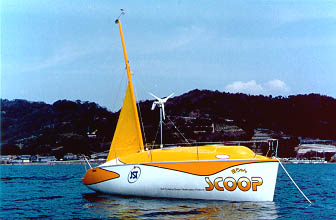Yamaha Motor Co., Ltd. recently designed and built an unmanned ocean atmosphere observation boat at the request of the Japan Science Foundation (Director: Masahiro Kawasaki; Location: Kawaguchi City, Saitama Pref.) and the launching of the new boat, named Kan-chan, took place at the end of March.
Until now, measurement of aerosol (colloidal particles) in the air over the oceans was limited to fixed observation stations on remote islands or a limited number of boats or observation buoys. As a result, with regard to large areas of open ocean, and in particular the North Pacific, it has not been possible to gather sufficient data. As the world's first mobile unmanned ocean atmosphere observation boat, the Kan-chan will make it possible to gather data over long periods and a wide area of the ocean, and it is hoped that its launch will make a big contribution to scientific research in areas such as the study of global warming.
Yamaha Motor's wide-ranging marine technology gleaned from long years of experience in the fields of small powerboat and sailboat design and construction has been put to full use in the design and building of the Kan-chan. |
 |
 |
 |
Features of the unmanned ocean atmosphere observation boat Kan-chan |
 |
 |
* |
Sailboat hull used:Because the observation boat's use calls for slow movement between locations and the ability to stay within a given area during measurement operations, the hull design of the Yamaha 26 II S sailing cruiser with its low resistance and excellent course-holding qualities was chosen as the base and re-designed along with the deck. Furthermore, the combination of a deck designed with the image of an orca and the low center-of-gravity hull, gives the Kan-chan a righting capability similar to that of a sailing cruiser. |
* |
Mast:The observation instruments are positioned atop the mast located at the stern of the boat, which can also raise a small sail to keep the bow of the boat pointed into the wind (thus enabling the boat to take waves from the bow). |
* |
Power system: The Kan-chan is outfitted with AC and DC generators powered by a diesel engine, plus a wind turbine generator. The observation instruments are run on AC100V - 1.2 KW current, while the boat's propulsions system (propeller) and rudder are powered on DC24V current. DC12V current is also supplied for the boat's control mechanisms and other equipment. The wind turbine generator provides back-up 12V power. The battery block consists of six 12V-80AH batteries. |
* |
Boat control system:The boat's control system consists of microcomputer and the various data-gathering instruments such as GPS, speedometer, compass, wind direction and speed gauges, etc. The boat is run and navigated automatically by means of a system in which satellite directions from land regarding destination are processed in relation to the boat's present position as determined by GPS and signals generated to provide appropriate motor rpm (boat speed) and rudder angle. |
** |
The design and construction of the above-mentioned boat and the design and production of all systems, including the propulsion system, boat control system and automatic navigation system were done solely by Yamaha Motor Co., Ltd. |
|
 |
 |
Main Specifications of the unmanned ocean atmosphere observation boat Kan-chan |
 |
 |
Overall length: 7.99 m:
overall width: 2.8 m;
displacement: 3,500 kg;
fuel capacity: 1,400 liters;
boat speed: 4 knots (in flat water);
hours of continuous running: 700 hrs.
(about one month of observation survey activity) |
|

|